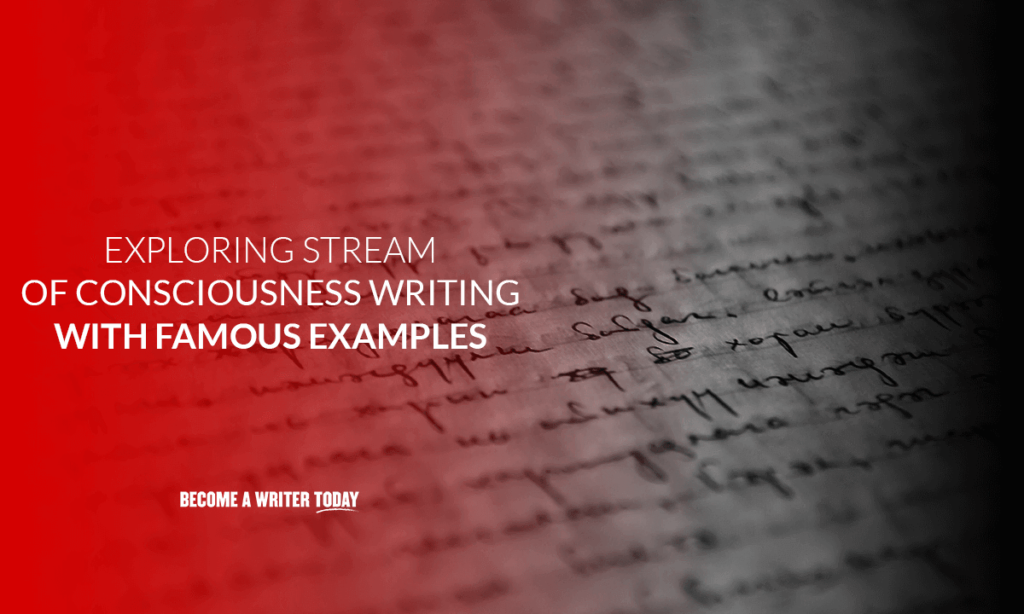What do thoughts look like on paper? Stream of consciousness writing is a literary technique that explores that exact thought!
When writing a novel, you have a number of different narrative techniques to consider. stream of consciousness writing is one of them.
This technique gives the reader an idea of what is going on in the minds of the characters and the narrator. The stream of consciousness style can be quite effective at gaining the interest of the reader and making them engage with what is happening to and around the character.
Yet it is not an easy technique to perfect. This guide will not only tell you what stream of consciousness writing is, but also how you can do it.
Contents
What Is Stream of Consciousness Writing?

A writer who uses stream of consciousness writing shows the interior monologue of the characters. The thoughts and emotions of a character or the narrator are written in such a way that the reader can always track that character’s thoughts. It may look like this:
- walking to the library / cold / I need books / singing birds / bright sun / forgot my sunglasses / here now
This is not a new technique. Many famous writers including Edgar Allan Poe and Leo Tolstoy used the technique in the 19th century, even before it was officially named.
In 1890, psychologist William James officially named the technique in his book The Principles of Psychology. Modernist writers, such as Virginia Woolf and James Joyce, embraced the style, and it has continued through modern writers.
Popular Examples of Stream of Consciousness Writing

One of the best ways to understand literary terms like stream of consciousness narrative writing is to look at examples. This isn’t hard to do, because this style of writing is incredibly popular. However, here are some examples that you may be familiar with:
1. Molloy by Samuel Beckett
In this 1951 novel, Beckett showed the stream of consciousness for several characters, not just one. Many monologues take place in the work, giving readers insight into the thoughts of the individual characters as the story unfolds.
- unknown author (Author)
- English (Publication Language)
- 01/01/1656 (Publication Date) - Grove Press (1994-01-12) (Publisher)
2. Ulysses by James Joyce
In 1922, Joyce wrote a novel about Leopold Bloom, an Irishman who goes about a seemingly normal day. The book’s entire premise is tracking Bloom’s thoughts through the day. It shows an incredible ability to copy the way a brain naturally moves from one thought to the next.
- Joyce, James (Author)
- English (Publication Language)
- 682 Pages - 09/18/2016 (Publication Date) - Digireads.com (Publisher)
3. Mrs. Dalloway by Virginia Woolf
Written in 1925, Mrs. Dalloway highlights the inner monologue of several characters throughout the story. Like Ulysses, Mrs. Dalloway tracks the details of the main character’s daily life as she moves through high-society in the post-War and post-Spanish-Flu world of the 1920s. It follows her for a single day and gives insights into the stream of thought of both the title character and the characters she meets.
- Portada aleatoria
- Woolf, Virginia (Author)
- English (Publication Language)
- 224 Pages - 09/24/1990 (Publication Date) - Mariner Books Classics (Publisher)
4. As I Lay Dying by William Faulkner
In this story, readers listen to the inner monologues of a group of family members as they take their mother and grandmother, Addie, to her final resting place. Several disasters befall the characters on their journey, and a final twist surprises most readers. It can be a bit hard to read, as there are inner dialogues for 19 different characters, but it shows clear mastery of this literary style.
- Great product!
- Faulkner, William (Author)
- English (Publication Language)
- 267 Pages - 01/30/1991 (Publication Date) - Vintage (Publisher)
5. “The Love Song of J. Alfred Prufrock” by T.S. Eliot
This is not a book, but rather a poem, but it shows the stream of consciousness technique just as well as a novel would. The poem presents a monologue of the main character as he tries to escape his own befuddled thoughts. In the poem, Eliot’s character, Pruforck, is considered a representation of modern man, free association of thought, and humankind’s inner battles.
- Amazon Kindle Edition
- Eliot, T.S. (Author)
- English (Publication Language)
- 98 Pages - 11/02/2009 (Publication Date) - Halcyon Press Ltd. (Publisher)
6. On the Road by Jack Kerouac
On the Road is unique because of its use of stream of consciousness writing as actual narration. The book follows Sal Paradise, the narrator, and main character, as he travels with his friend on four road trips across the country. As they travel, Paradise and his friend explore the meaning of life and the beauty of music.
- Jack Kerouac (Author)
- English (Publication Language)
- 293 Pages - 06/01/1999 (Publication Date) - Penguin Classics (Publisher)
How to Use Stream of Consciousness in Your Own Writing
If you are inspired by this literary technique, you may be wondering how to write your own stream of consciousness narrative. While reading someone’s internal monologue may make it look easy, it’s actually a very challenging writing technique. Here’s how you can do it.
Step 1: Choose Your Character or Topic
First, choose a character that you wish to follow as you write a flow of thoughts. If you don’t have a character in mind, consider a topic or activity that would be interesting to write about, and build a character around that.
Step 2: Throw Grammar out the Window
Stream of consciousness writing does not need proper grammar. Many of these works are characterized by a lack of punctuation and capitalization. Remember, you are writing thoughts, not proper grammatically correct sentences.
Consider, for example, this excerpt from Mrs. Dalloway:
“For having lived in Westminster—how many years now? Over twenty,–one feels even in the midst of the traffic, or waking at night, Clarissa was positive, a particular hush, or solemnity; an indescribable pause; suspense (but that might be her heart, affected, they said, by influenza) before Big Ben strikes. There! Out it boomed. First a warning, musical; then the hour, irrevocable.”
Mrs. Dalloway
This is how inner thoughts flow, and punctuation and syntax are not part of the picture.
Step 3: Write in First Person from the Character’s Point of View
Start writing, and keep your point of view from the mind of your character. Every word needs to be in the first person. Think not only of what the character sees and experiences but what they think about those experiences.
Step 4: Illustrate Thoughts and Feelings
Study authors who are known for their stream of consciousness writing, and model what they do in your own writing. Remember that free association is allowed. Every thought does not have to be tied to a preceding thought.
Step 5: Write Without Stopping
Stream of consciousness writers often writes without stopping. Interestingly, when writing On the Road, Kerouac had several writing sessions that he recorded on continuous rolls of typewriter paper, indicating he simply wrote without stopping his train of thoughts. You can do the same.
Step 6: Read and Revise Your Writing
Remember, this style of writing is challenging, so read and revise as needed. Consider reading your work out loud and asking yourself if it sounds like someone is thinking or having an internal dialogue. If it does, you have successfully created a stream of consciousness piece.
A Final Word On Stream Of Consciousness Writing
Stream-of-consciousness writing is not an easy form of writing, but when done well, it can be quite interesting and engaging. In this literary technique, you focus more on thoughts and feelings and less on syntax and grammar.
If you’re interested in this literary technique, the best way to get started is to first explore writers, like Woolf and Joyce, who did it well. After studying their works, try your own hand at this writing style. You may find that you enjoy writing freely and recording the inner monologues of your characters.
FAQs About Stream Of Consciousness Writing
What is stream of consciousness writing?
Stream of consciousness writing is writing that explores the inner dialogue, feelings and free-associative thoughts of a character in a story.
Which is the best example of stream of consciousness writing?
Virginia Woolf’s Mrs. Dalloway is one of the best-known examples of this literary technique.